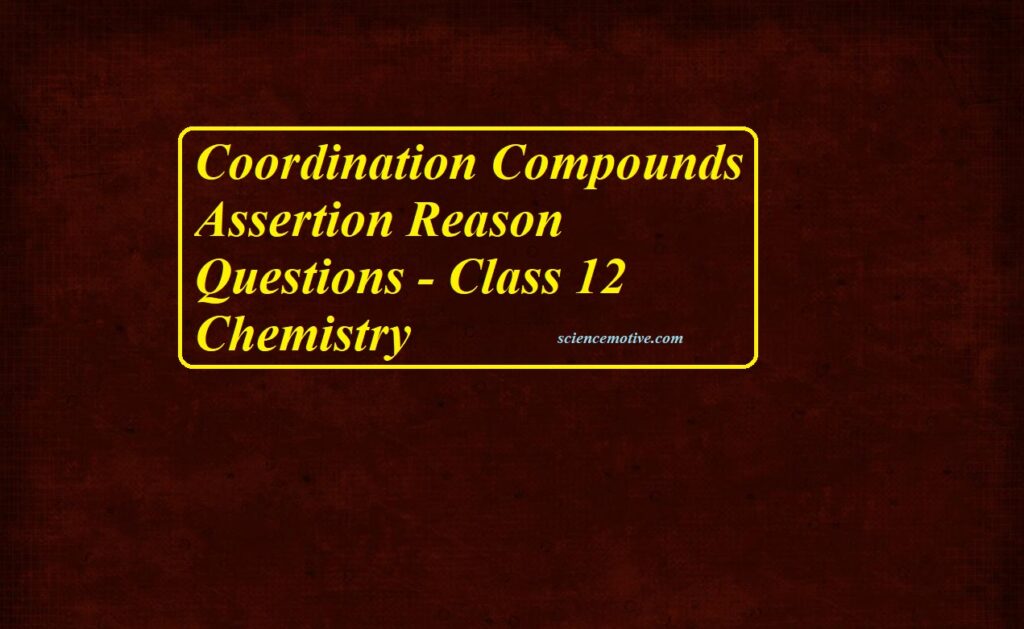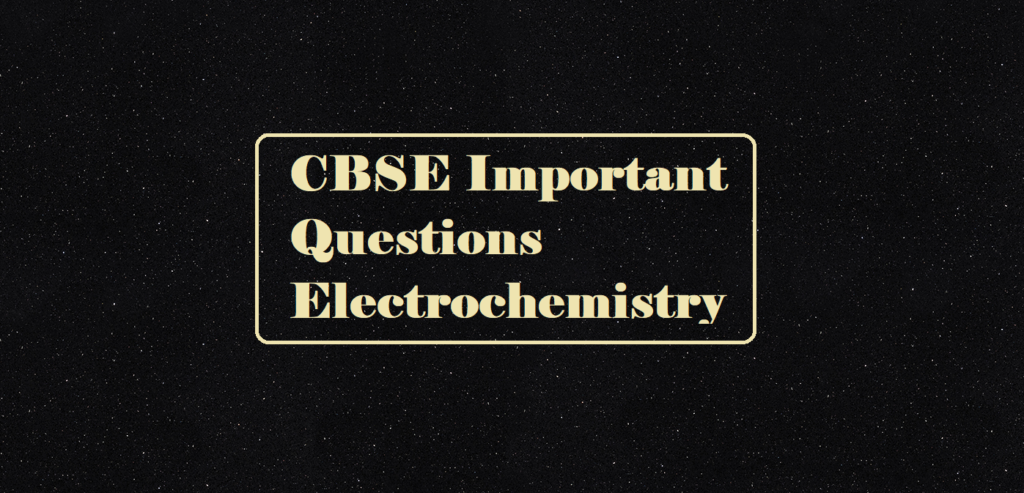Coordination Compounds Assertion Reason Questions
Coordination Compounds Assertion Reason Questions
(a) Assertion and reason both are correct and the reason is the correct explanation of assertion.
(b) Both assertion and reason are true but the reason is not the correct explanation of assertion.
(c) Assertion is correct but Reason is incorrect
(d) Assertion is a wrong statement but the reason is a correct statement
(e) Both Assertion and Reason are incorrect
1. Assertion: Toxic metal ions are removed by the chelating ligands.
Reason: Chelate complexes tend to be more stable.
Ans 1. (a) Assertion and reason both are correct and the reason is the correct explanation of assertion.
Toxic metal ions are removed by chelating ligands. When a solution of the chelating ligand is added to a solution containing toxic metals ligands chelates the metal ions by the formation of a stable complex.
2. Assertion: Linkage isomerism arises in coordination compounds containing ambidentate ligand. Reason: Ambidentate ligand has two different donor atoms.
Ans 2. (a) Assertion and reason both are correct and the reason is the correct explanation of assertion. Linkage isomerism arises in coordination compounds containing ambidentate ligands because ambidentate ligand has two different donor atoms. e.g. CN, SCN, NCS
3. Assertion: Complexes of MX6, MX5L type (X and L are unidentate) do not show geometrical isomerism.
Reason: Geometrical isomerism is not shown by complexes of coordination number 6.
Ans 3. (c) Assertion is correct but Reason is incorrect
In MX6 & MX5L, their shape is Square Bipyramidal. In a plane, there are four atoms, all are the same, linked to the metal atom, so they don’t show geometrical isomerism.
If the ligands present in complexes are Bidentate. Then they will show optical isomerism.
4. Assertion: [Fe(CN)6]3- ion shows magnetic moment corresponding to two unpaired electrons.
Reason: Because it has d2sp3 type hybridization.
Ans 4. (e) Both Assertion and Reason are incorrect
The assertion “[Fe(CN)6]3− ion shows magnetic moment corresponding to two unpaired electrons is false as it contains only one unpaired electron only d2sp3 hybridization, which cannot be regarded as a true reason for its weak paramagnetic behavior.
5. Assertion: [Ni(CN)4]2- is square planar and diamagnetic
Reason: It has no unpaired electrons due to the presence of a strong ligand.
Ans 5. (a) Assertion and reason both are correct and the reason is the correct explanation of assertion.
Coordination Compounds Assertion Reason Questions
6. Assertion: Oxalate ion is a bidentate ligand.
Reason: Oxalate ion has two donor atoms
Ans 6. (a) Assertion and reason both are correct and the reason is the correct explanation of assertion.
7. Assertion: [Ni(CO)4] has square planar geometry while [Ni(CN)4]4- has tetrahedral geometry
Reason: The geometry of any complex depends upon the nature of the ligands attached.
Ans 7. (d) Assertion is a wrong statement but the reason is a correct statement
8. Assertion: [FeF6]3- is a low spin complex.
Reason: Low spin complexes have a lesser number of unpaired electrons.
Ans 8. (d) Assertion is a wrong statement but the reason is a correct statement
9. Assertion: F– ion is a weak ligand and forms an outer orbital complex.
Reason: F– ion cannot be force the electrons of dz2 and dx2 – y2 orbitals of the inner shell to occupy dxy, dyz, and dzx orbitals of the same shell.
Ans 9. (a) Assertion and reason both are correct and the reason is the correct explanation of assertion.
10. Assertion: Potassium ferrocyanide and potassium ferricyanite both are diamagnetic.
Reason: Both have unpaired electrons.
Ans 10. (e) Both assertion and reason are false.
Potassium ferrocyanide and potassium ferricyanide both are not diamagnetic because both do not have paired electrons. Assertion and reason both are false.
11. Assertion: The [Ni(en)3]Cl2 (en = ethylene diamine) has lower stability than [Ni(NH3)6]Cl2
Reason: In [Ni(en)3]Cl2 the geometry of Ni is trigonal bipyramidal.
Ans 11. (e) Both assertion and reason are false.
[Ni(en)3]Cl2 is a chelating compound and chelated complexes are more stable than similar complexes involve the breaking of two bonds rather than one. In [Ni(en)3]Cl2, Ni with d8 configuration shows octahedral geometry. Six electrons will occupy the t2g orbitals and two electrons will occupy the eg orbitals.
12. Assertion: The ligands nitro and nitrito are called ambidentate ligands.
Reason: These ligands give linkage isomers.
Ans 12. (a) Both assertion and reason are true and the reason is the correct explanation of assertion.
When a monodentate ligand has two possible donor atoms and is attached in two ways to the central metal atom are called ambidentate ligands.
13. Assertion: Geometrical isomerism is also called cis-trans isomerism.
Reason: Tetrahedral complexes show geometrical isomerism.
Ans 13. (c) The assertion is true but the reason is false.
Tetrahedral complexes do not show geometrical isomerism because the relative position of the atoms with respect to each other will be the same.
14. Assertion: [Fe(CN)6]3– is weakly paramagnetic while [Fe(CN)6]4– is diamagnetic.
Reason: [Fe(CN)6]3– has +3 oxidation state while [Fe(CN)6]4– has +2 oxidation state.
Ans 14. (b) Both assertion and reason are true but the reason is not the correct explanation of assertion. [Fe(CN)6]3– has EAN equal to 35 and thus possesses unpaired electron to show paramagnetic nature while [Fe(CN)6]4– possesses no unpaired electron and thus shows diamagnetic nature.
15. Assertion: Potassium ferrocyanide is diamagnetic whereas potassium ferricyanide is paramagnetic.
Reason: Crystal field splitting in ferrocyanide ion is greater than that of ferricyanide ion.
Ans 15. (c) The assertion is true but the reason is false.
K4[Fe(CN)6] and K3[Fe(CN)6] both are low spin complex due to a strong ligand field. That is why it is false that crystal field splitting in ferrocyanide ions is greater than ferricyanide ions.
Coordination Compounds Assertion Reason Questions



